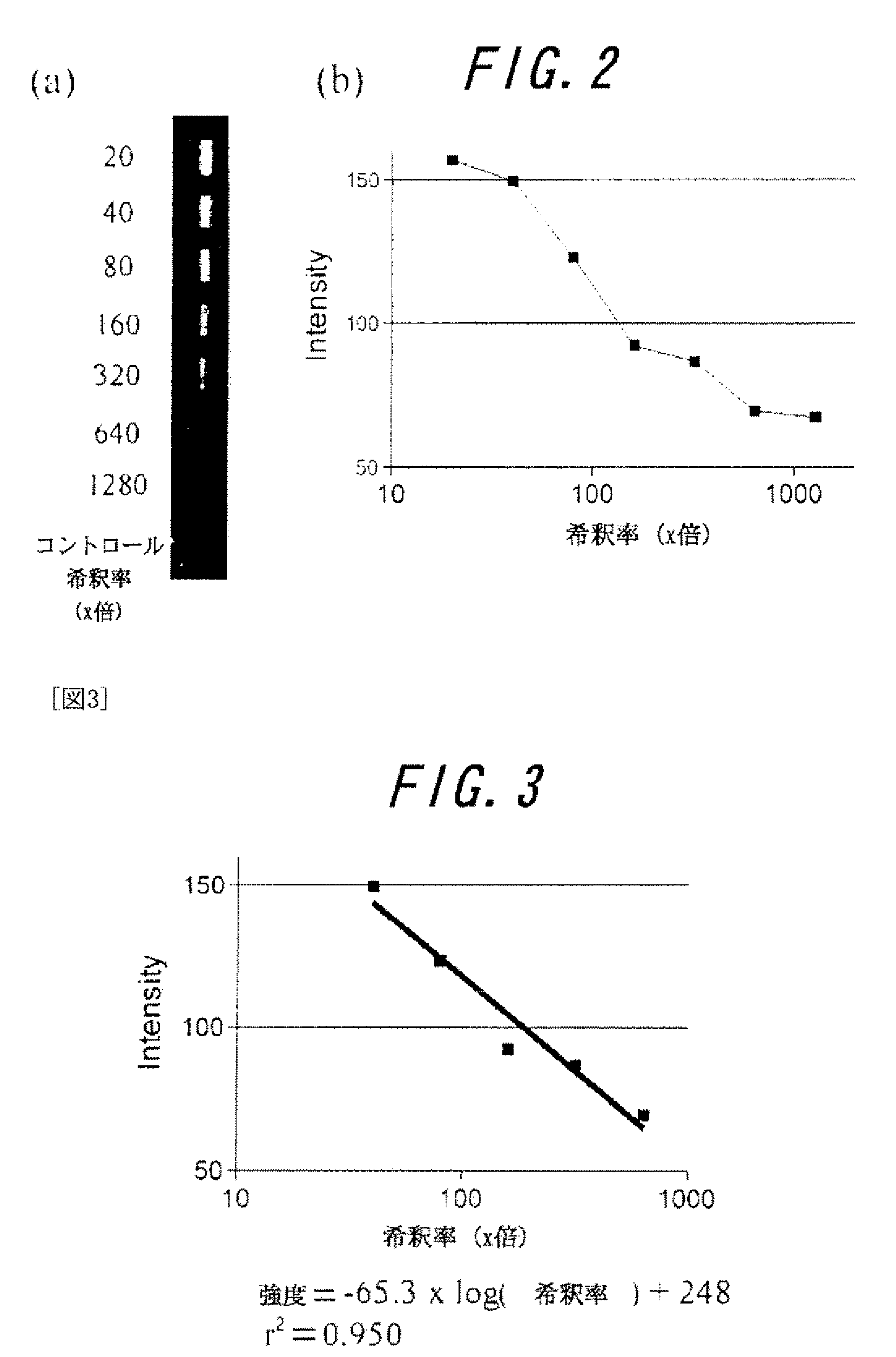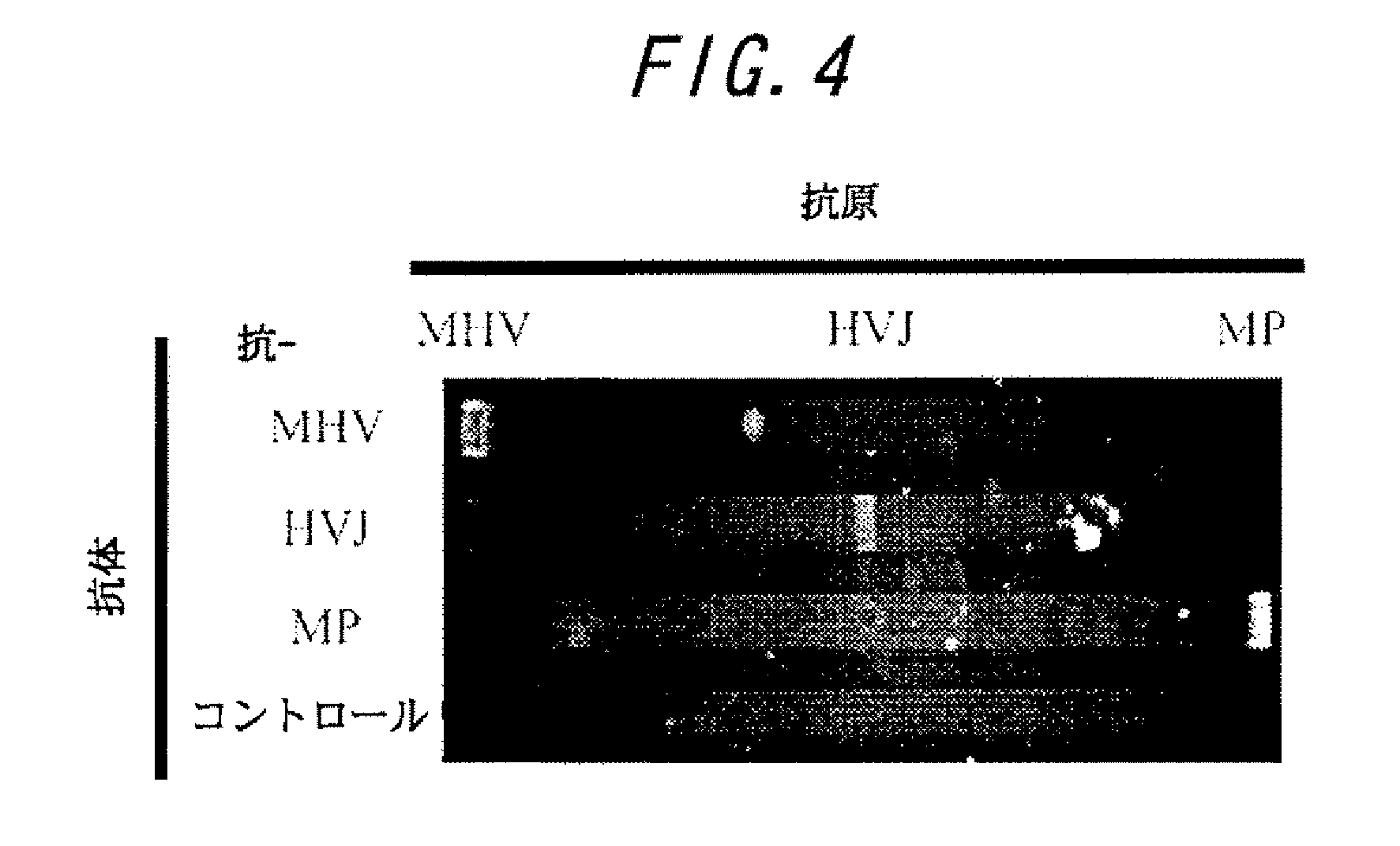Method of Monitoring a Microorganism That Causes Infectious Disease of a Laboratory Animal
a laboratory animal and microorganism technology, applied in the field of monitoring a microorganism, can solve the problems of antigen antibody reaction, take a long time for the test procedure, etc., and achieve the effects of low contamination of the facility, high throughput, and easy and rapid condu
- Summary
- Abstract
- Description
- Claims
- Application Information
AI Technical Summary
Benefits of technology
Problems solved by technology
Method used
Image
Examples
example 1
[0052] In the following experiments, PBS (Na2HPO4 0.61 g, KH2PO4 0.19 g, NaCl 8.00 g, KCl 0.20 g, MilliQ (Millipore) IL), PBST (0.05% Tween20-PBS), and a washing solution (2% skim milk-PBST), and a blocking solution (2% skim milk-PBST) were used, and they were composed of the compositions described in brackets. Surface of the substrate, where antigen antibody reaction was conducted, was coated with Indium-Tin Oxide (ITO) and a glass substrate (manufactured by Tatsunami glass, 26×76 mm) introduced with aldehyde group was used on the coated substrate.
[0053] At first, about 0.45 μg of mycoplasma (MP) antigen (DENKA SEIKEN Co., Ltd.) was sprayed on the substrate using an electrospray deposition device (manufactured by Fuence). At conducting the spray, a glass mask having a slit (width 200 μm, length 12 mm) was used. By using the mask, antigens were deposited on the substrate in the shape of thin linear figure. The substrate was set with a flow channel made of polydimethylsiloxane havin...
example 2
[0059] Cross reactivity was determined to examine on the cross contamination. In the same manner as example 1, antigens of pneumonia virus of Mice (MHV) (DENKA SEIKEN Co., Ltd.), Sendai virus (HVJ), and mycoplasma (MP) were sprayed by an electrospray deposition device. Thereafter anti-pneumonia virus of Mice (MHV) antibody, anti-Sendai virus (HVJ) antibody, and anti-mycoplasma (MP) antibody (DENKA SEIKEN Co., Ltd.) derived from mouse were passed through each flow channels as the primary antibodies, and the antigen antibody reactions were conducted. Then the amounts of antigens bound on the substrate were detected using anti-mouse antibody labeled with Alexa Fluor 488 as the secondary antibody. At the same time, a flow channel without flowing a primary antibody was set as a control. The results are shown in FIG. 4. According to the results, the non-specific binding of the secondary antibody was not observed in the control. On the other hand, it was revealed that respective antibodies...
example 3
[0060] Experiments on the actual samples were conducted using serum collected from mouse, The micro flow channel chip was sprayed and immobilized with the antigens of pneumonia virus of Mice (MHV) (DENKA SEIKEN Co., Ltd.), Sendai virus (HVJ), and mycoplasma (MP) using an electrospray deposition device. The test sample to be subjected to microorganism monitoring was diluted tenfold and 10 μl of the diluted sample was passed through the flow channels, then a labeled anti-mouse antibody was subjected for detection. As the result, antibody against pneumonia virus of Mice was detected in the test sample. Therefore it is assumed that the mouse is infected or has an infected record by pneumonia virus of Mice.
PUM
| Property | Measurement | Unit |
|---|---|---|
| volume | aaaaa | aaaaa |
| length | aaaaa | aaaaa |
| width | aaaaa | aaaaa |
Abstract
Description
Claims
Application Information
 Login to View More
Login to View More - R&D
- Intellectual Property
- Life Sciences
- Materials
- Tech Scout
- Unparalleled Data Quality
- Higher Quality Content
- 60% Fewer Hallucinations
Browse by: Latest US Patents, China's latest patents, Technical Efficacy Thesaurus, Application Domain, Technology Topic, Popular Technical Reports.
© 2025 PatSnap. All rights reserved.Legal|Privacy policy|Modern Slavery Act Transparency Statement|Sitemap|About US| Contact US: help@patsnap.com



